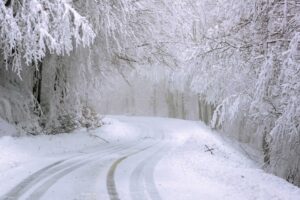Featured Image by Julius Silver from Pixabay
A normally relaxing activity turned nervous
Here in Canada, February marks the last full month of winter each year. However, the warmer temperatures still mostly elude us, and we continue to deal with the challenges of snow and ice as presented by the winter season. Traveling is perhaps one of the daily routine tasks that has been made the most difficult by the winter conditions, and it is crucial to stay safe when reckless behaviors only put everyone in jeopardy.
Preparing for the weather
Changing to winter tires is usually the first thing many drivers do to prepare for the oncoming winter. It is generally recommended to switch tires when the temperature falls less than 7 degrees Celsius. In advance, it would also be very beneficial to check the vehicle’s battery, brakes, heater, and windshield wipers before the snow and extreme cold season starts.
An emergency kit is also highly necessary for winter driving. An emergency kit should not only include a first aid kit, but also blankets, maps, extra clothing, flashlights, a fire extinguisher, and in some cases, a set of booster cables. Always keep the car’s gas tank more than halfway filled to reduce excess moisture building in the gas tank. This protects the car and ensures the driver won’t ever have to run out of fuel while driving in freezing conditions.
Every time before going out when snowing, check to make sure that the lights, as well as the license plates, are visible and free of snow and ice. It is also highly important to clean snow off of the windows (including side windows) and the side view mirrors.
Image by Ioannis Ioannidis from Pixabay
Driving Techniques
The Alberta Government website presents many good tips and advice on how to drive when the roads are slick and the daylight time is short. First, the speed at which drivers travel must be slower than the posted speed limit; individual conditions still vary, so make sure to still keep a proper speed on highways. Also, when encountering snowplows, follow behind them at a safe distance, until they permit you to pass by them. We should respect the safety of city road workers, as they are doing the great task of cleaning up our streets from snow.
It is also important that sudden turns, accelerating, and braking should be avoided. It is simply best to keep a safe following distance (in fact, three times as long as how you normally would keep) with the car ahead while avoiding exaggerated changes in speed and direction when turning or changing lanes. Also, drivers traveling on rural highways should not use cruise control, as it severely impedes the ability of the driver to make adjustments based on real-life condition changes.
When driving on bridge decks, always exercise an increased amount of caution, as the heat that warms up the ground is often reduced on bridges, making these settings more slippery to travel on. When driving through roads with natural curves, just keep the speed at an appropriate pace before entering the curve, and hold it steady. For traveling up hills, also make sure to keep the speed relatively constant throughout.
Losing control of the vehicle is very common in winter driving conditions. When this happens, the first thing the driver needs to do is to stay calm, and not brake harshly. Instead, release the brake and steer the wheel in the right direction. Start braking only when the car is under control again.
It truly takes the effort of everybody in the city, the residents, road workers, and the government (which provides Highway Operations), to maintain a high standard of safety when driving in extreme wintry conditions. As such, let’s all be responsible, patient, and prudent drivers and make sure everyone can get to their destination successfully at the end of the day!


